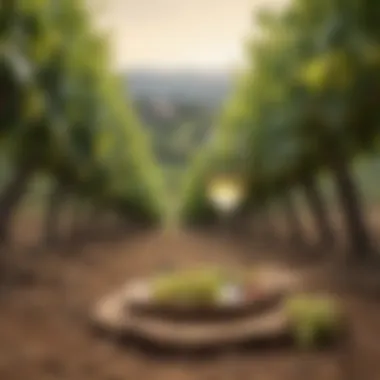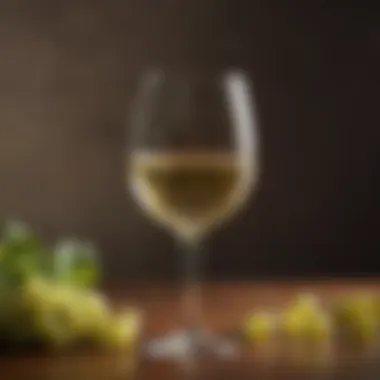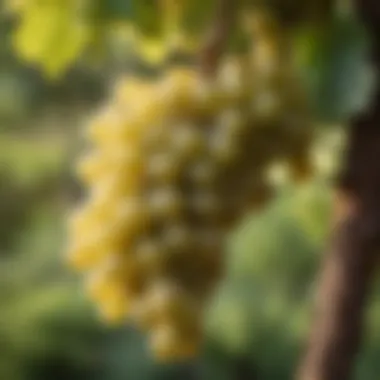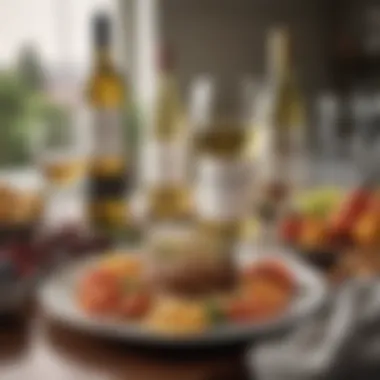Mastering the Art of Selecting Quality Chardonnay


Intro
Selecting a high-quality Chardonnay can seem like a daunting task for many wine enthusiasts. With so many variables to consider, it is vital to focus on the key characteristics that elevate a Chardonnay from mediocre to exceptional. Factors such as terroir, winemaking techniques, and tasting profiles will play important roles. Understanding these elements can significantly enhance the experience not only for novice drinkers but also for those with more refined palates engaged in the nuances of wine.
This guide aims to provide a thorough understanding of how to pick a solid Chardonnay. We will cover everything from the influence of natural environments in grape cultivation to the subtleties of its flavor profile. As one navigates through the intricacies of this fine wine, important criteria such as aroma, sweetness, and acidity come into focus, along with food pairing implications to elevate a meal. Navigating the world of Chardonnay doesn't have to be intimidating. In fact, informed choices can lead to discoveries of new favorites.
Following through this guide will not only equip readers with knowledge of Chardonnay but also enrich their experiences at stores, restaurants, and gatherings, leading to more satisfied palates.
Tasting Profiles of Chardonnay
Chardonnay presents a wide spectrum of tasting notes shaped largely by climate, region, and winemaking choices. When tasting, one might notice flavors that range widely:
- Fruity notes: Many Chardonnays evoke fruit flavors that can include apple, pear, and citrus fruits.
- Funky elements: Sometimes you may perceive flavors reminiscent of baked goods, provided by malolactic fermentation.
- Minerality: This denotes a subtle layer hinting at lead pencil or flint, often due to the soil in which the grapes are grown.
Proper tasting can reveal key information about the wine in question. Additionally, adherence to examining mouthfeel, length, and overall balance creates a heightened tasting experience. Given this complexity, subtleties are often overlooked, so it's essential to spend time indulging in the nuances.
The Role of Terroir in Chardonnay
Terroir encompasses how various factors such as soil, climate, and topography impact the character of the Chardonnay. Notably, different regions produce distinct flavor profiles:
- In cooler climates, such as Burgundy, expect wines that are more structured and florally expressive.
- Warmer climates, like California's Napa Valley, yield fruit-forward wines with bold excess sweetness.
A key aspect of selecting a Chardonnay involves recognizing how terroir can influence your choices on different occasions. The context of the wine enhances appreciation and fulfillment – thereby forging a connection between regions, drinks, and the scenarios in which they are enjoyed.
Winemaking Techniques
Understanding winemaking techniques adds another layer to selecting a splendid Chardonnay. Here are key methods that vary among producers:
- Malolactic fermentation: This process softens acidity and introduces creamy elements. A winemaker’s choice to adopt mala-winning fermentation defines the resultant flavor crucially.
- Oak aging: This is often used to imbue rich flavors and aromas. Toast levels during the aging also provide varying influences; knowing the winemaker’s approach on oak selection can guide choices towards or away from a distinctive style.
Such considerations enable consumers to forge preferences and expectations around taste and texture, enriching the experience.
To select a Chardonnay aligned to its tasting profile, one must actively engage not just with brands, but about where the wine comes from and how it was made.
Prelims to Chardonnay
Chardonnay is one of the most celebrated varietals gaining prominence in the wine world. Understanding this grape is essential for selecting the best Chardonnay suitable for varying palates and occasions. The Chardonnay variety embodies complexity, offering a diverse range of flavors influenced heavily by many factors. Knowing what makes a great Chardonnay can greatly enhance your wine experience.
Historical Background
Chardonnay traces its origins back to France, specifically the Burgundy region. Its name is derived from a small village in the same area. Historically, Chardonnay was cultivated primarily in the Burgundy region, where the wines produced showcased a rich flavor profile. As it matured, wineries outside of France recognized the potential of this grape, leading to its adoption across the globe, including premier regions like California, Australia, and New Zealand. These complexities not only enriched the wine market, but they also equipped wine enthusiasts with an expanded array of flavors that evoke various impressions and emotions.
Popularity in the Wine Market
The appeal of Chardonnay spans a vast audience and is dominant in wine markets worldwide. Its versatility in flavor—from crisp and refreshing to deep and oaky—means there is usually a Chardonnay to suit virtually any preference. In recent years, the grape has maintained top rankings in terms of sales across various platforms, enjoying a significant share compared to other whites. Furthermore, trends show that it goes well with many cuisines, making it a staple choice for food enthusiasts.
Chardonnay enjoys a unique position due to its adaptability. Some wine lovers opt for more incrementally complex palates that enjoy the infusion of oak or the buttery notes achieved through malolactic fermentation. Such factors contribute to an increased interest in experimenting with various styles and regions, which keeps the curious mind engaged and wanting more. In our discerning context, picking a great bottle of Chardonnay presents an opportunity for knowledge and superior enjoyment.
Understanding Terroir
Understanding terroir is crucial when choosing a good Chardonnay. Terroir encompasses the unique set of environmental factors that affect the growth of grapevines, influencing the characteristics of the wine produced. Knowing about these factors aids consumers in recognizing varietal traits and enhances their appreciation of Chardonnay.
Definition of Terroir
Terroir refers to the specific environment in which grapes are grown, including climate, soils, topography, and even local traditions of viticulture. Each of these elements contributes distinctly to the flavor profile of the wine. In essence, terroir shapes not only how grapes develop but also how they express themselves once fermented. This unique interaction is what makes wines from different regions distinct, despite being made from the same grape variety.
Terroir influences the sensory qualities of wine, making the location as important as the grape itself.
Influence of Climate


Climate plays a vital role in determining the taste and quality of Chardonnay. It affects grape ripeness, which influences sugars and acidity levels. Warmer climates often produce ripe, fruity Chardonnays, while cooler climates yield a fresher, more mineral-focused profile.
Temperature fluctuations during the growing season can introduce complexities that shape the overall balance of the wine. Additionally, the climate can affect how grapes react to various diseases, pests, and potential yields. Understanding these climatic effects can guide enophiles in selecting Chardonnays that best suit their palates or desired food pairings.
Soil Types and Their Impact
The specific soil types where Chardonnay grapes grow significantly influence the resulting wine quality and character. Different soil compositions—from rocky to clay or loamy—determine how well grapevines can drain water, how nutrients are absorbed, and how the grape’s natural flavors are expressed.
- Chalky soil contributes vibrant acidity and a crisp structure. Regions such as Champagne thrive on this soil type.
- Clay and limestone soil lends depth and a rich texture to wines, promoting the complexity characteristic of Chablis.
- Sandy soil allows for excellent drainage yet can limit flavor concentration, making wines more delicate.
Each wine enthusiast looking for exceptional Chardonnay should consider how soil types influence their choice. This foundational understanding of terroir empowers wines lovers to make better selections that align with their taste preferences.
Grape Selection
Selecting the right grapes is fundamental when choosing a quality Chardonnay. This section deliberates on crucial aspects surrounding grape selection including particular characteristics, prominent growing regions, and the distinction between single varietal and blended options. A deep dive into these concepts significantly enriches your understanding, influence future choices, and enhances your overall wine-drinking experience.
Key Chardonnay Characteristics
One cannot successfully appreciate Chardonnay without understanding its key characteristics. Primary aspects of this grape include its extensive flavor profile and versatility. A well-crafted Chardonnay can display flavors ranging from crisp apples and fresh citrus to buttery nuances depending on the vinification approach. Its aging potential also varies remarkably. Chardonnays from cooler regions often retain higher acidity with flavors leaning towards more floral or mineral, while those from warmer environments may progress to richer, deeper crowning notes of stone fruit and caramel.
These features are crucial for determining their overall quality and utility in pairing with food. A complex flavor profile allows for wider food pairages, benefiting both home mastercooks and casual diners. Understand this not as mere attractive traits but rather as indicators of meticulous production processes.
Regions Known for Chardonnay
The provenance of Chardonnay grapes significantly impacts their tastes, textures, and overall drinking experience. Noteworthy locations with exceptional Chardonnay include:
- Burgundy, France: Known as the ancestral home, Burgundy produces Chardonnays noted for their subtlety and complexity.
- California: Particularly areas like Napa Valley and Sonoma County, California produces Chardonnays that often showcase roundness and fruit-forward characteristics.
- Australia: Adelaide Hills and Margaret River regions are recognized for producing vibrant and diverse styles of Chardonnay.
This geographical context underscores that picking Chardonnay is as much about discerning where it is from as it is about its definitive notes. Awareness of a region’s climate and soil lends invaluable insight into appreciating the nuances each area brings to a bottle.
Single Varietal vs.
Blended Chardonnay
When it comes to choosing between single varietal and blended Chardonnays, understanding the implications bcomes important for making informed decisions.
- Single Varietal: A pure expression of Chardonnay allowed to fully articulate its legacy. Expect distinctive aromas and tastes, embodying the true spirit of the grape, providing unrivaled authority with food pairings.
- Blended Chardonnay: These wines employ mixing with other varietals, adapting flavors and potentially mellowing aggressive notes. Often aiming for balance and complexity, blended wines may open up diverse palate experiences.
Recognizing these decisions helps to navigate through diverse offerings effortlessly. Discuss your preferences further with professionals at your local wine store to maximize your purchase experience.
To summarize, informed selections can greatly impact your Chardonnay choices. By grasping the key characteristics, regional distinctions, and the nuances of single varietal versus blended forms, you are well-equipped to venture further into the complex world of this graceful wine variety.
Winemaking Techniques
Winemaking techniques play a crucial role in the character of a Chardonnay. The choices made during vinification significantly affect the final product. Understanding these techniques helps consumers appreciate the nuances of different Chardonnays and empowers them to make informed selections.
Different Fermentation Methods
Fermentation transforms grape juice into wine by converting sugars into alcohol. There are primarily two types of fermentation methods: open fermentation and closed fermentation.
- Open fermentation often exposes the juice to natural yeast. This method can enhance unpredictable and complex flavors but may introduce unwanted bacteria.
- Closed fermentation typically uses stainless steel tanks which control temperature and maintain consistency. This method is beneficial in preserving the fresh fruit qualities of the Chardonnay.
Different winemakers often opt for these methods based on their desired wine style. For passionate wine drinkers, knowing more about fermentation methods enriches the tasting experience.
Use of Oak Barrels
The decision of whether or not to use oak barrels is critical. Oak barrels impart flavors and contribute to the texture of the wine. Two particularly significant types of oak are French and American.
- French oak tends to add subtler flavors such as vanilla and spice, making it a preferred choice for classic Chardonnays.
- American oak can introduce more intense flavors such as coconut and caramel. This choice impacts the final palate of the wine and might appeal to those preferring bold profiles.
Also, the age of the barrels influences intensity: new barrels share more flavor, while used barrels contribute more softness.


Malolactic Fermentation
Malolactic fermentation (MLF) is a secondary fermentation utilized in many Chardonnay productions.
This process converts malic acid, which is sharp, into lactic acid, creating a smoother finish. MLF adds complexity to the wine, offering a creamier mouthfeel and potentially buttery notes, which many Chardonnay enthusiasts enjoy.
Considerations about MLF include:
- Style Preference: Not all palates appreciate the buttery quality. Therefore, if this is undesirable, look for terms like unoaked or non-MLF on the label.
- Balanced Acidity: Understanding the role of MLF allows consumers to appreciate the balance of acid, often a defining feature of a great Chardonnay.
Understanding winemaking techniques helps consumers make aesthetic choices about Chardonnay. Enhancements in flavor, texture, and position of acidity are paramount during your selection process.
By becoming familiar with these winemaking techniques, one can discern differences between Chardonnays to find a one that satisfies individual tastes.
Tasting Profiles of Chardonnay
Understanding the tasting profiles of Chardonnay is critical. It helps you discern what you may prefer in a wine. The tasting profile provides insight into the character and quality of the Chardonnay. It offers frameworks for both novice and well-versed wine enthusiasts. A good grasp of the tasting profiles helps in making informed choices in your selection.
Identifying Aromas
Aromas are the first interaction one has with Chardonnay. When you pour a glass, the scents wafting can tell a story. Each scent contributes to the overall impression. Aromas in Chardonnay often include:
- Citrus fruits, like lemon and grapefruit
- Stone fruits, including peach and apricot
- Floral notes, such as honeysuckle or jasmine
- Spice notes, encompassing nutmeg or vanilla from oak aging
This distinct range of aromas may vary based on the terroir and winemaking techniques. Getting accustomed to these aromas allows appreciation of nuances that milder wines may lack. Identifying them can elevate one’s wine tasting experience while enjoying Chardonnay.
Tasting Notes and Flavor Profiles
Once the wine is in your mouth, you access its flavor profiles. Chardonnay can surprise your palate, offering diverse tasting notes. Some key flavors could be:
- Fruity influences, where you may find tropical notes like pineapple or papaya
- Mineral qualities, especially in wines from cooler climate regions
- Oakiness, presenting creaminess from malolactic fermentation
- Electric sharpness comprising zesty acidity that cleanses the palate
These flavors bind together, often leading to a complex but pleasant finish. When tasting Chardonnay, pay attention to how the flavors unfold on your palate.
Acidity and Body Structure
The acidity in Chardonnay is essential for its structure. This wine is usually categorized into different levels based on body:
- Light-bodied Chardonnay tends to be crisp, with higher acidity.
- Medium-bodied wines present well-balanced acidity paired with creamy texture.
- Full-bodied options exhibit rich flavors with oak influence and lower acidity.
Higher acidity often correlates with longer durability, making these wines age-worthy. On the other hand, the body structure invites varied food pairing possibilities. Balancing acidity and body helps vastly in the enjoyment of Chardonnay.
Understanding the tasting profiles emphasizes your whole wine experience and leads to better pairing choices, enhancing meals and interactions.
Evaluating Quality in Chardonnay
Evaluating quality in Chardonnay is a crucial aspect for anyone seeking to understand and appreciate this popular wine. A good Chardonnay can offer a lovely balance of flavors, but not all Chardonnays are created equal. By evaluating the factors that contribute to quality, wine drinkers can make informed choices. It involves tasting, smelling, and considering several elements from production to the final product.
Price vs.
Quality Relation The relation between price and quality in Chardonnay deserves attention. A higher price does not automatically guarantee excellence. Factors like region, vintage, and winemaking practices all influence cost. When buying, consider the following points:
- Region Influence: Regions known for quality Chardonnay, like Burgundy in France or Napa Valley in the United States, often command higher prices due to their reuptation and production methods.
- Supply and Demand: Collectible vintages, or limited editions may cost significantly more. Demand can drive prices, impacting your purchasing decision.
- Consumer Reviews: Better-rated winery's Chardonnays might require a higher budget, but reviewing customer feedback on their quality versus price is essential.
It’s wise to balance these factors. Less expensive options doesn't mean poor quality; some remarkable values exist in less prominent regions.
Certifications and Ratings
Certifications and ratings help in assessing the quality of Chardonnay. They provide an objective measure of quality that can guide buyers. Consider the importance of these evaluations:
- Wine Ratings: Organizations like Wine Spectator or Parker's Wine Advocate offer wine scores based on thorough tastings. High scores are often synonymous with quality, but preference still plays a huge role.
- Organic and Sustainable Certifications: Wines that are certified organic or sustainable have distinct production standards and environmental commitments, making them appealing for eco-conscious consumers.
- Regional Appellations: Knowing the wine's origin through guidelines ensures the wine meets certain quality requirements. French AOC or Italian DOC designations are strong indicators of quality.


Always look for these certifications or accolades from reputable organizations while evaluating a Chardonnay.
Food Pairing with Chardonnay
The selection of a good Chardonnay is elevating experience, and matching it with appropriate food enhances both the wine and the meal's flavors. Chardonnay's versatility suits a wide range of dishes, from delicate seafood to rich poultry. Understanding food pairing principles allows for strategic complementing or balancing wines with the dish.
Complementary Flavors
Chardonnay typically exhibits flavors such as citrus, green apple, and stone fruit. Depending on the winemaking techniques, it can also showcase creaminess and hints of nutty oak. When pairing food, look for wines that enhance these flavors without overpowering the dish.
For example, the acidity of a Chardonnay cuts through fatty elements beautifully. A rich grilled salmon or creamy lobster risotto would be splendid choices. On the other hand, a lightly oaked Chardonnay can pair well with roasted vegetables to highlight mellower tastes. The key is to ensure that the wine's profile balances the dish rather than competes with it.
Considerations for Pairing
- Match the weight of the dish with the body of the wine.
- Look for seasonings and herbs that express the wine’s nuances.
- Use the cooking method as a guide, grilled or roasted enhancing those richer notes.
Dish Suggestions
A thoughtful dining experience amplifies Chardonnay's elevation role in the culinary world. Diverse dishes abound that pair empathically with Chardonnay’s refreshing style. Some notable dish choices include:
- Grilled Chicken: Marinate in herb-infused lemon for a fresh, acidic touch that complements soft fruit flavors in Chardonnay.
- Seafood Pasta: From clams to shrimp, subtly seasoned with garlic and herbs aligns well with Chardonnay’s vibrant profile.
- Creamy Risotto: The texture and rich flavors align perfectly with the rich texture found in barrel-aged Chardonnays.
- Mushroom Risotto: It allows the earthiness of mushrooms to contrast against the vibrant taste of Chardonnay.
- Cheese Platter: Soft cheeses like Brie or Camembert serve alongside Chardonnay; the creaminess contrasts well with the acidity.
Food has a way of enhancing wine, and vice versa. Combining them thoughtfully leads to memorable meals.
By grasping the foundational flavors of both Chardonnay and the dishes you contemplate, you enrich your dining method. This careful crafting not only delivers satisfying meals but also deepens the appreciation for quality Chardonnay wines.
Where to Buy Quality Chardonnay
Buying quality Chardonnay is a crucial part of the overall experience, especially for those who appreciate the nuances of this varietal. Understanding where to purchase assures that you obtain a product that not only meets quality standards but also aligns with your preferences and intentions for enjoyment.
Acquiring a good Chardonnay can lead to enhanced satisfaction, whether paired with a meal or enjoyed on its own. It is essential to identify reliable sources that offer not only authenticity but proper storage conditions and an array of selections to explore.
Retail Options
Retail options count as a valuable resource. Many wine shops focus on stocking quality wines. They can often provide personal guidance, elevating the shopping experience. When engaging with knowledgeable staff, you have greater chance to discover desirable characteristics associated with a Chardonnay.
- Local Wine Shops: These shops tend to curate selections carefully. They purchase from reputable distributors focusing on quality over quantity. The staff can often suggest wines based on your preference and any meal pairings.
- Supermarkets: Large supermarket chains also offer Chardonnay. However, quality may vary widely depending on stock. It's possible to find reputable brands, yet, assessing wine directly can be misleading. Seeking high-end selections at larger supermarkets may help.
- Wine Festivals: Visiting local wine festivals allows tasting different varieties. Often, you can meet the producers, showcasing their passion and quality. These direct interactions enhance understanding of the wine you may choose to purchase later.
Online Platforms
Online purchasing gives convenience and broadened selection. You may find wines from different regions and availability often exceeds what local stores may provide. Here are some considerations when buying Chardonnay online:
- Wine-specific Websites: Websites like Wine.com or Vivino offer an extensive inventory of brands, vintages and regions. It's beneficial because they include reviews and ratings from users. Comparisons for price are easily made clearly indicating what represents the best value.
- Local Retailers Going Online: Many local wine specialty shops now have online storefronts. This allows loyalty to local businesses while expanding selection options. Also check for shipping promotions or memberships for recurrent orders.
- Marketplace Platforms: Places such as Amazon can sometimes also carry quality selections, yet buyer reviews will determine the source’s reliability.
Buying quality Chardonnay involves understanding sources for a well-rounded selection.
The importance of selecting a reliable point of sale cannot be overstated, as it influences your experience with this exquisite wine. Identify what fits your needs: A knowledgeable in-store guide or the convenience of an online order. The choice you make shapes your discovery of quality Chardonnay.
Epilogue and Final Thoughts
In this article, the exploration of Chardonnay reflects a significant journey that many wine enthusiasts undertake. Understanding the nuances behind selecting a good Chardonnay is not just about picking a bottle off the shelf. It encaptures the interaction between terroir, winemaking practices, taste profiles, and food pairings.
Choosing an excellent Chardonnay can greatly enhance culinary experiences. Specifically, oenne might remember how important it is to pair flavors correctly and appreciate the olfactory sensations unique to each bottle. Grapes cultivated in specific regions impart their own character, shaped by soil and climate. This understanding encourages one to explore various wines beyond mere labels.
Recap of Key Points
- Historical Context: The article began by discussing Chardonnay's background, placing it in a larger context of wine culture.
- Terroir: We covered how terroir determines the wine's profile, influenced by diverse climates and types of soil.
- Grape Selection and Quality: Key characteristics to look for when choosing Chardonnay have been addressed, stressing the importance of quality over quantity.
- Winemaking Techniques: Different methods, including fermentation and oak aging, significantly affect the final taste.
- Tasting Notes: Understanding aromas and flavor notes enriches the tasting experience.
- Food Pairing: Suggestions were made to complement flavors, making for well-rounded meals.
- Where to Buy: Insight on retail and online platforms was provided, aiding in finding quality options.
Encouragement for Exploration
Wine discovery is, in essence, a personal journey. Individuals are encouraged to seek out various Chardonnays, engage with local sommeliers, or attend tasting events. Consideration for both reputable brands as well as smaller family-run vineyards can lead to delightful surprises. Exploring the vast world of wine is both engaging and rewarding.
Not only does this enhance your knowledge, but also enriches culinary experiences. Don't shy away from trying something new or spark up enviable conversations with fellow wine enthusiasts. Remember, every bottle tells a story worth sharing and savoring.
"Wine is sunlight, held together by water." — Galileo
Ultimately, we hope that this guide serves as a foundation from which you can appraise and appreciate Chardonnay on deeper levels.







